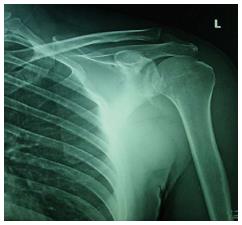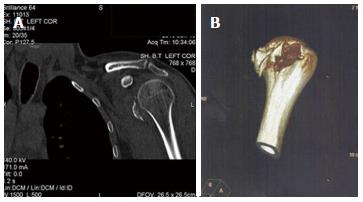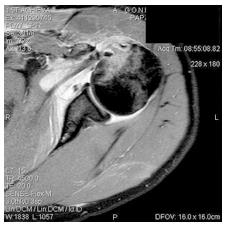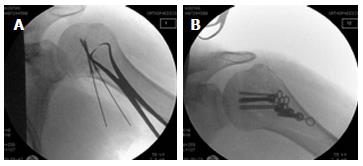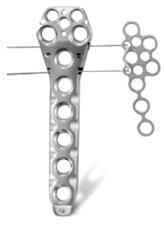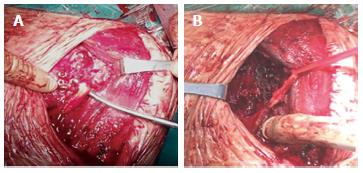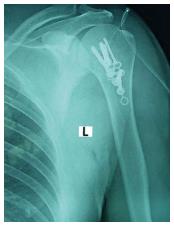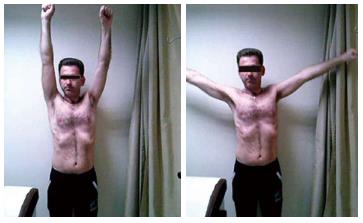Published online Jun 16, 2014. doi: 10.12998/wjcc.v2.i6.219
Revised: April 17, 2014
Accepted: May 14, 2014
Published online: June 16, 2014
Fractures of the lesser tuberosity of the humerus are typically met in combination with other injuries of the shoulder. Case reports of isolated lesser tuberosity fractures are particularly rare and, consequently, therapeutic protocols have not yet been completely clarified. Conservative as well as surgical treatment has been recommended, while several operative techniques have been applied. We present a case of a 39-year-old man with an isolated lesser tuberosity fracture who was treated surgically in our institution. Due to fracture comminution, a two-level reconstruction technique with headless screws and buttress plate was applied. As far as we know, this method of fixation of this type of fracture has not been previously described in the literature. The patient tolerated the procedure well and excellent results were obtained at the latest follow-up.
Core tip: Isolated fractures of the lesser tuberosity of the humerus in adults are extremely rare. Only a few cases have been reported so far in the literature. The optimal treatment method of these fractures is still a matter of debate. Herein, we present a case of a 39-year-old man with an isolated lesser tuberosity fracture who was treated surgically in our institution. Due to fracture comminution, a two-level reconstruction technique with headless screws and buttress plate was applied. As far as we know, this method of fixation of this type of fracture has not been previously described in the literature.
- Citation: Nikolaou VS, Chytas D, Tyrpenou E, Babis GC. Two-level reconstruction of isolated fracture of the lesser tuberosity of the humerus. World J Clin Cases 2014; 2(6): 219-223
- URL: https://www.wjgnet.com/2307-8960/full/v2/i6/219.htm
- DOI: https://dx.doi.org/10.12998/wjcc.v2.i6.219
Five percent of all humeral fractures involve the proximal end alone[1,2]. Out of this, only 2% account for isolated lesser tuberosity fractures, making the incidence extremely rare. More often, they are seen as an isolated injury or with a combined posterior dislocation of the shoulder[3]. Moreover, these fractures may be difficult to identify because of the osseous overlapping in the standard x-ray examination or they are misdiagnosed as intra-articular loose bodies or calcifications of the rotator cuff[4].
The injury typically requires traumatic abduction and external rotation of the upper arm in relation to the shoulder. The forceful contraction of the subscapularis muscle leads to the avulsion fracture of the lesser tuberosity.
Epidemiologically, little is known but it has been described as an injury that involves male patients between the 2nd and 5th decades of life and youngsters with an open humeral physis. If not treated or missed, these injuries may lead to subscapularis weakness and/or impingement of the malunited part[5,6].
Generally, open reduction and internal fixation is the treatment of choice in otherwise medically fit patients but some authors suggest conservative treatment for minimally displaced fractures and report clinically successful results[7,8].
Operative procedures can be challenging in cases of comminuted fractures of the lesser tuberosity. We present a case of a comminuted isolated avulsion fracture of the lesser tuberosity of the humerus in a young male patient. A two-level reconstruction technique is described.
A 39-year-old male presented to our emergency department with a history of a fall from a height of about 2 m on to his outstretched left arm. On clinical examination, there was tenderness on palpation on the frontal aspect of the proximal humerus and restriction of movements of the joint, energetically and passively. No neurovascular damage was noted.
Standard anteroposterior radiograph revealed a crescent-shaped fragment near the inferior part of the glenoid rim. At that point, lateral X-ray was not possible due to patient’s pain (Figure 1).
The patient was admitted to our orthopedic department and a computed tomography (CT) scan was performed to describe the damage in greater detail (Figure 2). A magnetic resonance imaging (MRI) scan was also performed to exclude possible intra-articular damage and/or tendon pathology (Figure 3).
The isolated comminuted avulsion fracture of the lesser tuberosity was confirmed, with no other intra-articular pathology of the shoulder joint. It was decided to operate and the patient was transferred to the operating room 48 h after the injury.
Under general anesthesia and with the patient supine in the so-called beach chair position, with the image intensifier placed on the opposite side of the operating table, a standard deltopectoral approach was used. Fragments of the avulsed lesser tuberosity with the subscapularis tendon were identified. The fracture did not extend to the articular surface or the bicipital groove. Initially, the larger fragment of the avulsed lesser tuberosity was reduced using reduction forceps. Two cannulated Herbert screws were used to stabilize the fragment (Figure 4). The smaller fragments were then reduced and stabilized using a low profile, bendable neutralization buttress plate (T-plate, NCB proximal humerus, Zimmer Company, Winterthur, Switzerland) (Figure 5). The long head of the biceps tendon was identified and found to be stable (Figure 6). Excellent fracture reduction was confirmed with intraoperative fluoroscopy (Figure 4). A drain was positioned and the wound was closed in the usual fashion. Figure 7 shows the immediate post-operative X-ray.
The arm was placed in a sling in a neutral position and the elbow flexed 90 degrees. The patient was released from the hospital 2 d post-operatively. Immediately after stitches removal, the patient initiated his rehabilitation program, with passive assisted exercises to regain full range of motion. Six weeks post-operatively, active exercises were implicated.
On follow-up, the patient had achieved painless full range of motion and regained his normal activities. X-ray examination at the latest follow-up, 18 mo after surgery, revealed full union of the fracture and no hardware failure (Figures 8 and 9).
Approximately 2% of proximal humeral fractures are isolated fractures of the lesser tuberosity[9]. This demonstrates how rarely those injuries are met. Until now, the lack of an extensive published case series does not allow the determination of a standard therapeutic protocol for this type of fracture. The small sized lesser tuberosity, which is adequately protected in the medial aspect of the proximal humerus, is not frequently fractured and, when this happens, sudden contraction of the subscapularis muscle, which is attached to the tuberosity and prevents the abduction and external rotation of the shoulder, is the most common mechanism of injury[6]. The clinical presentation of the patient, characterized by pain particularly in the frontal aspect of the shoulder and restricted motion, is not typical and requires proper radiographic control, which generally includes at least two views of the shoulder. Although in our case the fracture can be noted in the anteroposterior view of the shoulder, often the diagnosis is missed or delayed due to the lack of a complete imaging. An axillary view especially generally demonstrates lesser tuberosity fractures most clearly and possibly displaced fragments[10]. However, on plain radiographs, these fractures may be misdiagnosed as calcific tendonitis of the rotator cuff or osseous Bankart lesions[8].
Thus, the usefulness of a CT scan in the diagnosis and treatment of this type of fracture, including the surgical technique for its fixation, is particularly important[2]. More specifically, a CT scan is a valuable tool in the hands of the surgeon for the estimation of specific characteristics of the fracture, such as displacement, comminution and possible involvement of the articular surface[2]. Further investigation with MRI can also help in determining possible severe soft tissue damage, including rotator cuff tendon injury, or severe trauma of the articular surface.
Once the diagnosis is made, several therapeutic options have been proposed. Conservative treatment, although not frequently indicated, has its own remarkable position in the therapeutic “arsenal”, particularly in minimally displaced fractures[10] and in children[11,12]. However, controversy exists about the displacement of fracture as an indication of surgery; some authors recommend open reduction and internal fixation of even minimally displaced fractures in order to avoid late displacement and involvement of the bicipital groove[7]. Generally, operative treatment is recommended in cases of displacement more than 5 mm, angulation more than 45 degrees, persistent pain, blockage to motion and significant clinical weakness[5].
Regardless of the size or displacement of the fractured fragments, a review of the literature demonstrates that open reduction and internal fixation is the gold standard of the management of isolated lesser tuberosity fractures. Apart from open reduction and internal fixation, other methods of surgical treatment do exist and have generally given satisfactory results; surgical excision of the fractured fragment[13-15] and arthroscopically assisted reduction[16] have been proposed by several authors and have been proven efficient.
The common technique of open reduction and internal fixation of isolated lesser tuberosity fractures described in the literature includes the use of screws, cerclage wire[6] and, particularly in skeletally immature patients, the use of heavy sutures and suture anchors[5].
In conclusion, as far as we know, a two-level reconstruction of this type of fracture with headless screws and a buttress plate has not been previously described. The fact that led us to this surgical option was the comminution of the fracture and subsequent inability of adequate fixation with screws only. The larger fragments of the fracture were successfully fixed with headless Herbert screws. The smaller fragments were buttressed using a low profile, multi-hole plate. This plate also provided a more secure fixation of the larger fragments. As was proven, the clinical outcome was satisfactory and comparable with other cases in which different surgical methods were applied.
Isolated fracture of the lesser tuberosity of the humerus in a young adult male.
There was tenderness on palpation on the frontal aspect of the proximal humerus and restriction of movements of the joint, energetically and passively. No neurovascular damage was noted.
Shoulder fracture dislocation, rotator cuff pathology and/or osseous Bankart lesion were considered in the differential diagnosis based on patient’s symptoms. X-ray examination, computed tomography (CT) scan with 3D reconstruction and magnetic resonance imaging (MRI) of the injured shoulder were carried out.
Standard anteroposterior radiograph revealed a crescent-shaped fragment near the inferior part of the glenoid rim. Further examination with CT scan and 3D CT reconstruction confirmed the diagnosis and revealed the comminution of the lesser tuberosity avulsion fracture. MRI exam of the left shoulder excluded intra-articular extension of the fracture or other tendon ruptures.
Due to fracture comminution, a two-level reconstruction technique with headless screws and buttress plate was applied.
Isolated fractures of the lesser tuberosity of the humerus are extremely rare in adults. Open reduction and internal fixation is usually the treatment of choice. In the setting of severe fragment comminution, adequate stabilization of the fractured lesser tuberosity can be challenging. Using the proposed operative technique, with two-level reconstruction of the lesser tuberosity, resulted in excellent fracture healing and the clinical outcome was satisfactory and comparable with other cases in which different surgical methods were applied.
This is a well written case report describing a new surgical approach. It will be of general interest to orthopedic surgeons.
P- Reviewers: Naugler C, Serhan H, Solomon LB S- Editor: Song XX L- Editor: Roemmele A E- Editor: Wu HL
| 1. | Palvanen M, Kannus P, Niemi S, Parkkari J. Update in the epidemiology of proximal humeral fractures. Clin Orthop Relat Res. 2006;442:87-92. [PubMed] [Cited in This Article: ] |
| 2. | Kristiansen B, Barfod G, Bredesen J, Erin-Madsen J, Grum B, Horsnaes MW, Aalberg JR. Epidemiology of proximal humeral fractures. Acta Orthop Scand. 1987;58:75-77. [PubMed] [Cited in This Article: ] |
| 3. | Robinson CM, Teoh KH, Baker A, Bell L. Fractures of the lesser tuberosity of the humerus. J Bone Joint Surg Am. 2009;91:512-520. [PubMed] [DOI] [Cited in This Article: ] [Cited by in Crossref: 38] [Cited by in F6Publishing: 38] [Article Influence: 2.5] [Reference Citation Analysis (0)] |
| 4. | Chun JM, Groh GI, Rockwood CA. Two-part fractures of the proximal humerus. J Shoulder Elbow Surg. 1994;3:273-287. [PubMed] [DOI] [Cited in This Article: ] [Cited by in Crossref: 36] [Cited by in F6Publishing: 31] [Article Influence: 1.0] [Reference Citation Analysis (0)] |
| 5. | Levine B, Pereira D, Rosen J. Avulsion fractures of the lesser tuberosity of the humerus in adolescents: review of the literature and case report. J Orthop Trauma. 2005;19:349-352. [PubMed] [Cited in This Article: ] |
| 6. | Ogawa K, Takahashi M. Long-term outcome of isolated lesser tuberosity fractures of the humerus. J Trauma. 1997;42:955-959. [PubMed] [Cited in This Article: ] |
| 7. | Sugalski MT, Hyman JE, Ahmad CS. Avulsion fracture of the lesser tuberosity in an adolescent baseball pitcher: a case report. Am J Sports Med. 2004;32:793-796. [PubMed] [DOI] [Cited in This Article: ] [Cited by in Crossref: 35] [Cited by in F6Publishing: 36] [Article Influence: 1.8] [Reference Citation Analysis (0)] |
| 8. | van Laarhoven HA, te Slaa RL, van Laarhoven EW. Isolated avulsion fracture of the lesser tuberosity of the humerus. J Trauma. 1995;39:997-999. [PubMed] [Cited in This Article: ] |
| 9. | Gruson KI, Ruchelsman DE, Tejwani NC. Isolated tuberosity fractures of the proximal humeral: current concepts. Injury. 2008;39:284-298. [PubMed] [DOI] [Cited in This Article: ] [Cited by in Crossref: 100] [Cited by in F6Publishing: 90] [Article Influence: 5.6] [Reference Citation Analysis (0)] |
| 10. | Tosun B, Kesemenli CC. Isolated avulsion fracture of lesser tuberosity of the humerus: Review of the literature and report of two cases. Int J Shoulder Surg. 2011;5:50-53. [PubMed] [DOI] [Cited in This Article: ] [Cited by in Crossref: 8] [Cited by in F6Publishing: 9] [Article Influence: 0.7] [Reference Citation Analysis (0)] |
| 11. | Ross GJ, Love MB. Isolated avulsion fracture of the lesser tuberosity of the humerus: report of two cases. Radiology. 1989;172:833-834. [PubMed] [DOI] [Cited in This Article: ] [Cited by in Crossref: 57] [Cited by in F6Publishing: 57] [Article Influence: 1.6] [Reference Citation Analysis (0)] |
| 12. | Shibuya S, Ogawa K. Isolated avulsion fracture of the lesser tuberosity of the humerus. A case report. Clin Orthop Relat Res. 1986;215-218. [PubMed] [Cited in This Article: ] |
| 13. | Kunkel SS, Monesmith EA. Isolated avulsion fracture of the lesser tuberosity of the humerus: A case report. J Shoulder Elbow Surg. 1993;2:43-46. [PubMed] [DOI] [Cited in This Article: ] [Cited by in Crossref: 25] [Cited by in F6Publishing: 24] [Article Influence: 0.8] [Reference Citation Analysis (0)] |
| 14. | Berbig R, Keller H, Metzger U. Isolated fracture of the lesser tuberosity of the humerus: case reports and review of the literature. Z Unfallchir Versicherungsmed. 1994;87:159-168. [PubMed] [Cited in This Article: ] |
| 15. | LaBriola JH, Mohaghegh HA. Isolated avulsion fracture of the lesser tuberosity of the humerus. A case report and review of the literature. J Bone Joint Surg Am. 1975;57:1011. [PubMed] [Cited in This Article: ] |
| 16. | Scheibel M, Martinek V, Imhoff AB. Arthroscopic reconstruction of an isolated avulsion fracture of the lesser tuberosity. Arthroscopy. 2005;21:487-494. [PubMed] [DOI] [Cited in This Article: ] [Cited by in Crossref: 57] [Cited by in F6Publishing: 57] [Article Influence: 3.0] [Reference Citation Analysis (0)] |









